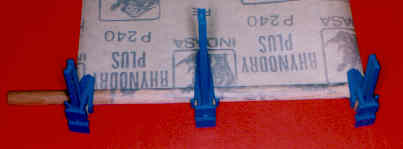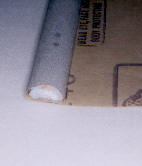
Updated January 2007
Home Made Tools
Go to Main Menu
Return to Tools Index
Gluing Table:

| Glue slot |  |
| Stop |  |
| Baseboard |  |
Procedure:-
1 - Baseboard made from MDF or plywood about 6" x 4" (150 x 100 mm).
2 - Two Stops are required. One against the side edge and one against the top edge.
These can be made from any suitable stripwood, for example, 1/4" (6mm)
square. When fitting these to the table, use the try square as they must be at
right angles to prevent your furniture being out-if-true.
3 - The optional Glue Slot.
About 1/8" [3 mm] wide this provides an escape path for excess glue that may ooze out of a joint being glued.
Sanding Stick
A sanding stick is a half-round length of timber on which a fine grade abrasive has been fastened. The flat face is used to sand regular shapes while the covex face will smooth both internal and external fretsawn curves.


 |
Abrasive paper |
 |
Clamp |  |
Half-round timber |
| Alternative style Clamp |  |
Procedure:-
1 - Obtain a 12" (300 mm) length of half-round timber about 1/2" (12 mm) across the flat.
2 - Spread a layer of glue over the flat section of the stick for the length of the abrasive.
3 - Press this along one edge of the abrasive and firmly clamp.
4 - Allow the glue to set.

5 - Spread glue over the abrasive just glued onto the sanding stick.
6 - Fold the abrasive paper tightly round the sanding stick pressing it into the glue.
7 - Clamp again and allow the glue to set.
8 - Using an old blade in the craft knife, carefully cut away the excess abrasive.
Note: the abrasive will blunt a new blade!
© 2007 Neil Helsby